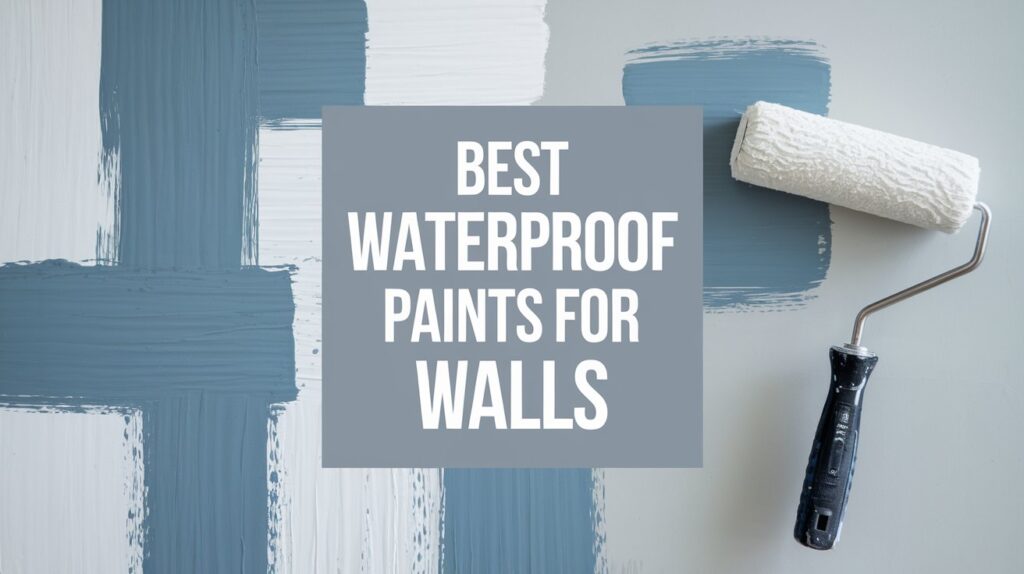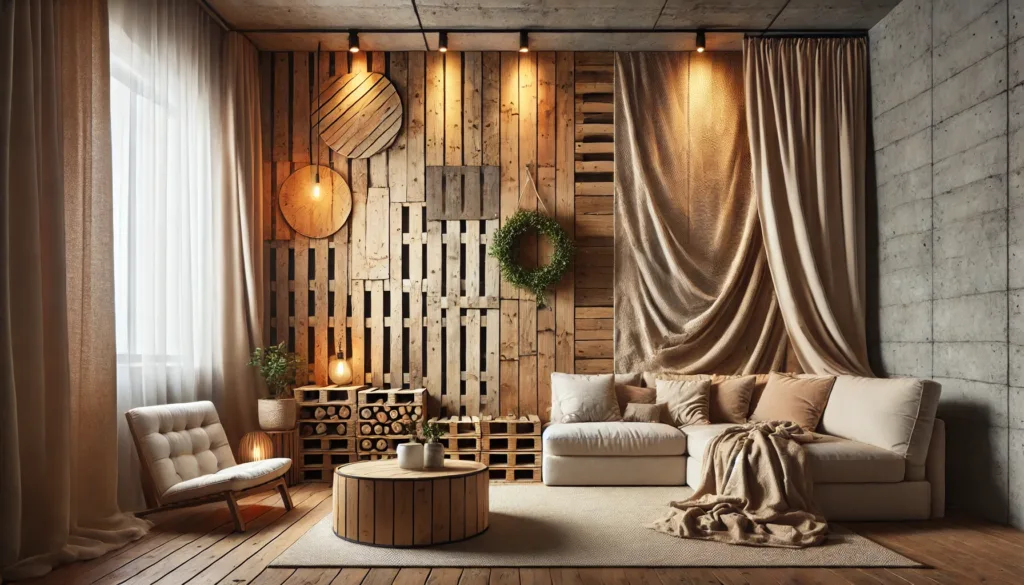As a homeowner, I’ve seen how a new paint job can change a kitchen. The right paint can make your kitchen look new and even increase your home’s value. But, with so many paints out there, picking the best paint for kitchen cabinets can be hard. I’m here to help you understand what makes a paint perfect for your kitchen cabinets.
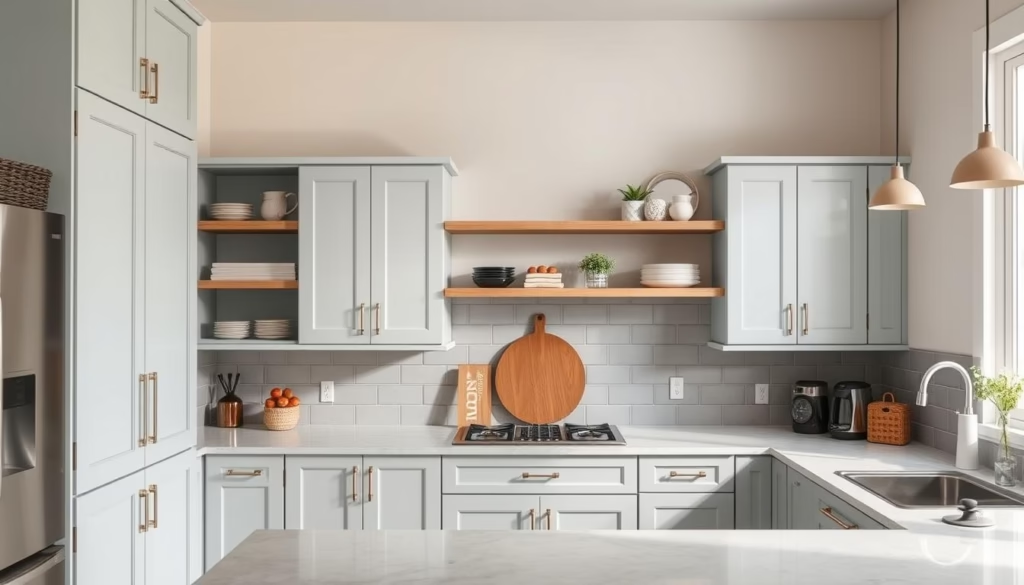
Key Takeaways
- Understand the differences between oil-based, water-based, latex, and alkyd paint formulations for kitchen cabinets.
- Explore top-performing cabinet paint brands and products that offer exceptional durability and finish quality.
- Consider essential factors like durability, kitchen environment, and budget when choosing the right cabinet paint.
- Learn about the pros and cons of professional-grade versus DIY cabinet paints.
- Discover color selection strategies and how paint finishes impact the overall kitchen aesthetics.
Understanding Different Types of Cabinet Paint
Choosing the best affordable paint for your kitchen cabinets is key. There are many types, each with its benefits. Let’s explore what type of paint is best for kitchen cabinets.
Oil-Based vs. Water-Based Formulations
Oil-based paints are known for their durability and glossy finish. They resist wear and moisture well, perfect for kitchens. But, they have a strong smell and need more cleaning than water-based paints.
Water-based paints, or latex, are gaining popularity. They’re easier to use, clean up, and smell less. They’re also better for the environment and dry faster. While not as durable as oil-based, they still offer a lasting finish.
Latex vs. Alkyd Properties
Water-based paints come in latex and alkyd types. Latex paints are flexible and won’t crack with temperature changes. Alkyd paints are harder and better for busy areas like kitchens. They also apply smoother and have a higher sheen.
Specialty Cabinet Paint Features
There are special cabinet paints for kitchens too. They offer better adhesion, and stain resistance, and are easy to clean. Some even have primer built-in, making painting easier and lasting longer.
Best Paint for Kitchen Cabinets: Top Brands and Products
The market has many high-quality paint options But we often have a question what is the best paint to use on kitchen cabinets? Brands like Benjamin Moore Advance and Sherwin-Williams Emerald Urethane Trim Enamel offer durable finishes. These are great for busy kitchens.
Benjamin Moore Advance is a favorite for its durable paint for cabinets. It’s oil-based, has great adhesion, and resists scratches and chipping. People love how easy it is to apply and the wide color choices.
| Brand | Product | Key Features | Customer Ratings |
|---|---|---|---|
| Benjamin Moore | Advance | – Oil-based formula – Excellent adhesion and durability – Smooth, even finish – Wide range of color options | 4.8 out of 5 stars |
| Sherwin-Williams | Emerald Urethane Trim Enamel | – Water-based formula – High-gloss, durable finish – Excellent flow and leveling – Resistant to stains and scratches | 4.7 out of 5 stars |
| Behr | Alkyd Semi-Gloss Enamel | – Oil-based formula – Exceptional coverage and hiding power – Durable, washable finish – Easy application and clean-up | 4.6 out of 5 stars |
Sherwin-Williams Emerald Urethane Trim Enamel is also a top pick. It’s water-based and has a high-gloss finish. People like its smooth application and stain resistance.
Behr’s Alkyd Semi-Gloss Enamel is great for oil-based fans. It covers well, hides imperfections, and is easy to clean. It’s a durable, washable finish.
Choosing the best finishes for kitchen cabinets requires looking at each product’s features. By checking out these top brands, you can find the perfect paint for your kitchen. This will give you a beautiful, lasting finish.
Essential Factors to Consider When Choosing Cabinet Paint
When picking cabinet colors or the best durable paint for cabinets, several key factors are important. These help you choose wisely, making your kitchen look great and last long.
Durability Requirements
Kitchen cabinets deal with moisture, heat, and daily wear and tear. Pick a paint that can handle these challenges well. Look for paints that stick well, keep their color, and are easy to clean.
Kitchen Environment Considerations
The kitchen is a tough place, with steam, grease, and spills common. When choosing cabinet colors or durable paint for cabinets, go for paint that resists moisture and is easy to clean. Semi-gloss or satin finishes are good because they fight stains and stay shiny.
Budget Constraints
Painting your kitchen cabinets can cost a lot, so think about your budget. While high-end paints cost more, they last longer and perform better. Compare the cost with how long it will last and how much upkeep it needs to find the best deal.
By thinking about these important factors, you can pick the right cabinet paint. It will make your kitchen look great and last for years, with a finish that’s easy to keep up.
Professional-Grade vs. DIY Cabinet Paints
When painting your kitchen cabinets, you face two main choices: professional-grade paints or DIY options. Knowing the differences between these can guide you to the right choice for your project. This includes your goals, budget, and skill level.
Professional-grade kitchen cabinet paint is made for lasting durability and a smooth finish. These high-quality paints are pricier but offer a flawless look that lasts. On the other hand, DIY types of paint for kitchen cabinets are cheaper. They’re great for those watching their budget.
| Feature | Professional-Grade | DIY |
|---|---|---|
| Durability | Highly durable, resistant to chipping, peeling, and fading | This may result in a less consistent or textured finish |
| Finish Quality | Produces a smooth, even, and high-quality finish | May result in a less consistent or textured finish |
| Application Ease | Requires specialized application techniques and tools | Easier to apply, often with a simpler application process |
| Cost | More expensive, but can provide long-term value | More budget-friendly, but may require more frequent repainting |
The choice between professional-grade and DIY kitchen cabinet paint depends on your needs and preferences. Consider the pros and cons of each to find the best fit for your project.
Color Selection Guide for Kitchen Cabinets
Choosing the right cabinet colors can change how your kitchen looks and feels. Whether you’re picking kitchen cabinet paint or just looking at choosing cabinet colors, this guide will help. It covers color trends, psychology, and matching your kitchen’s style.
Popular Color Trends
Recently, people have chosen cabinet colors that are warm, deep, and classy. Soft, muted tones like sage green, dusty blue, and rich charcoal gray are popular for their timeless elegance. On the other hand, bold, vibrant hues like emerald, navy, and even black add a modern, dramatic touch to kitchens.
Color Psychology in Kitchen Design
The colors for your kitchen cabinet paint can really change the mood of your kitchen. Warm, earthy tones like honey or terracotta make the space cozy and inviting. Cooler shades like white or light gray can make it feel clean and fresh.
Think about how colors make you feel and match them with your kitchen’s vibe.
Matching Colors With Kitchen Style
- For traditional or classic kitchens, timeless colors like white, off-white, or rich wood tones are best for a classic look.
- In modern or contemporary kitchens, bold, saturated hues or minimalist neutrals fit well with the sleek design.
- For farmhouse or rustic kitchens, muted greens, blues, or warm, weathered wood finishes add a cozy feel.
The kitchen cabinet paint colors should match your style and kitchen design. By looking at trends, color psychology, and your kitchen’s style, you can make a space that looks great and feels right.
Paint Finishes and Their Impact on Kitchen Aesthetics
Choosing the right paint finish for your kitchen cabinets is key. Each finish, from matte to high-gloss, changes how your kitchen looks and feels. They can make your cabinets look new and exciting.
Matte finishes give a soft, velvety look that’s timeless and elegant. They’re great for traditional or farmhouse kitchens because they’re not too shiny. Satin finishes offer a bit of shine, making your kitchen feel warm and welcoming. They’re perfect for choosing cabinet colors that match your kitchen’s style.
Semi-gloss finishes are a good middle ground. They’re easy to clean and work well in busy kitchens. High-gloss finishes, on the other hand, make your kitchen look sleek and sophisticated. They reflect light, adding depth and elegance.
When choosing cabinet colors and finishes, think about your kitchen’s style, the light it gets, and what you like. The right finish can make your kitchen look amazing, combining beauty and practicality.
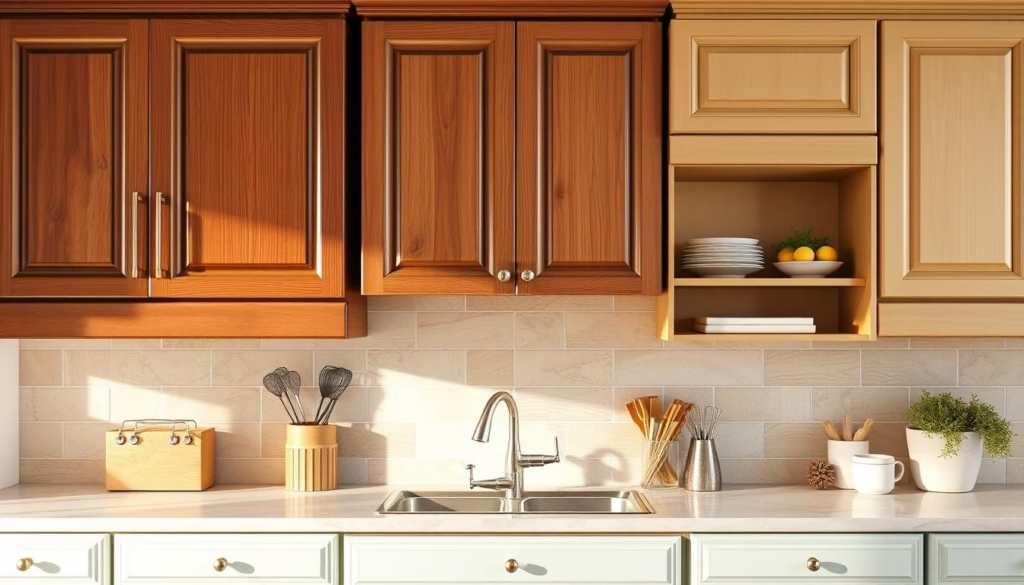
“The right paint finish can transform the entire look and feel of your kitchen, elevating the space with a perfect blend of style and functionality.”
Surface Preparation Techniques for Cabinet Painting
Getting your kitchen cabinets to look professional starts with surface prep. Cleaning, degreasing, sanding, and priming are crucial steps. These steps are key to a successful cabinet painting project. They ensure your types of paint for kitchen cabinets stick well and last long.
Cleaning and Degreasing Methods
Begin by cleaning your cabinets well. Use a degreaser or warm water with mild soap to remove grease and grime. This makes the paint stick better to the cabinets. Make sure to rinse well and let dry before moving on.
Sanding and Priming Requirements
Then, sand the cabinets lightly with a fine-grit sandpaper. This smooths out any rough spots and gives the paint something to hold onto. After sanding, clean off dust and apply a good primer. The primer is essential for the paint to stick and for a smooth finish.
| Cabinet Painting Tip | Explanation |
|---|---|
| Use a Deglosser | A deglosser can help remove any existing sheen or glossy finish, further improving the paint’s ability to bond to the surface. |
| Sand Lightly Between Coats | Light sanding between primer and paint coats can help create a smoother, more even finish. |
By using these prep techniques, you’ll get a beautiful and lasting cabinet painting job in your kitchen.
“Proper surface preparation is the foundation for a flawless cabinet painting project.”
Application Methods and Tools
To get a professional look when painting your kitchen cabinets, you need the right tools and techniques. You can brush, roll, or spray, each with its benefits and things to think about.
Brushing for Precision
A high-quality paintbrush is key for getting into tight spots and edges. It gives you control, perfect for detailed work or small cabinets. Choose a brush made for cabinet finishes, with smooth bristles.
Smooth Rollering Technique
For big, flat surfaces, a foam roller works well. It’s faster than brushing and makes the paint look even. But, keep the paint wet to avoid marks when you overlap.
Efficient Spray Painting
Spray painting is quick and gives a smooth finish, great for detailed designs. It needs more prep, like covering nearby areas to stop overspray.
Choosing the right tools is essential, no matter how you paint. Get good brushes, rollers, and a spray gun for a perfect job.
| Application Method | Advantages | Considerations |
|---|---|---|
| Brushing | Precise control Ideal for detailed work Good for small cabinets | Time-consuming Potential for visible brush strokes |
| Rolling | Faster than brushing Smooth, even coverage | Requires maintaining a wet edge Potential for lap marks |
| Spraying | Professional-looking finish Ideal for intricate designs Faster application | More preparation required Risk of overspray |
Choosing the right method and tools for painting your cabinets is crucial. Think about your cabinets and what you like to get the best results. This will help you achieve a beautiful, lasting finish.
Common Mistakes to Avoid When Painting Cabinets
Painting your kitchen cabinets can be a rewarding DIY project. But, it’s key to avoid common mistakes that can ruin the final look. As an experienced cabinet painter, I’ve seen many issues, from bad paint choices to sloppy applications. By avoiding these mistakes, you can have a smooth and successful painting experience.
Application Errors
Many homeowners rush the painting process. But, proper surface prep is vital for a flawless finish. Skipping sanding, cleaning, and priming can cause adhesion problems, peeling, or an uneven look. Make sure to clean and sand well, and always prime before painting.
Using the wrong tools is another common error. Cheap brushes or rollers can leave unsightly marks or an uneven coat. Invest in quality tools, like angled brushes and high-density foam rollers, for a smooth finish.
Product Selection Mistakes
Choosing the wrong paint can ruin your project. Oil-based and latex paints have different benefits and drawbacks. Picking the wrong one can cause wear, chipping, or the wrong sheen. Always pick a paint that’s durable, easy to clean, and fits your cabinet materials.
Also, picking the wrong cabinet colors can mess up your kitchen’s look. Take time to think about color trends, kitchen style, and your preferences. Choose a color that complements your space well.
By avoiding these mistakes, you can get a professional-looking, long-lasting cabinet painting job. It will truly change the heart of your home.
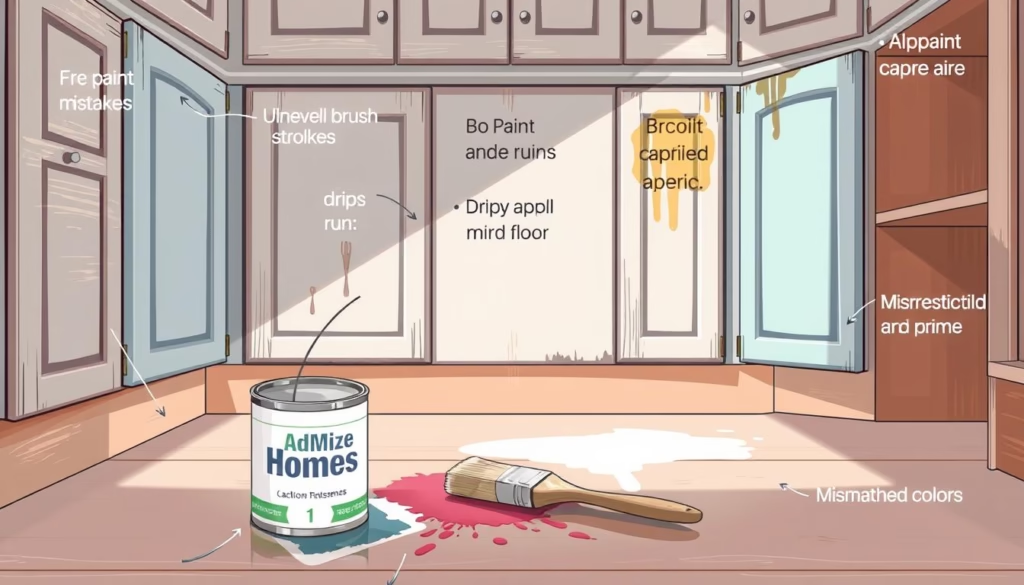
Maintenance and Care for Painted Cabinets
Keeping your painted kitchen cabinets looking great is a bit of work, but it’s worth it. Whether you choose a durable paint or a top-notch finish, taking good care of them will make your investment last. This way, your cabinets will stay beautiful for many years.
Cleaning and Upkeep
Cleaning your painted cabinets regularly is key to stopping grease, grime, and other kitchen messes. Use a soft, non-abrasive cleaner and a gentle cloth to clean them. Stay away from harsh chemicals or rough scrubbing, as they can harm the paint over time. For stubborn stains, a mild soap and water mix might work, but make sure to rinse well.
Touch-Up and Repairs
Even with the best care, your cabinets might get minor chips, scratches, or wear. Luckily, fixing them is easy. Keep a small amount of the original paint for touch-ups. Lightly sand the damaged spot, clean it, and apply a thin layer of paint. Make sure to blend the edges well for a smooth look.
Long-Term Preservation
- Try to avoid direct sunlight, as it can fade or change the color of the paint.
- Every few years, consider adding a clear, protective topcoat to keep the paint underneath looking good.
- Keep an eye on your kitchen’s environment. Try to reduce moisture, heat, and humidity, as they can affect the paint’s life.
By following these easy care tips, your durable paint for cabinets and best finishes for kitchen cabinets will stay in top shape for years. A well-maintained painted cabinet system not only makes your kitchen look better but also saves your investment in this key home improvement.
Cost Analysis: Paint Options and Long-term Value
When picking kitchen cabinet paint, cost matters a lot. The choice between expensive and cheap paint affects your investment’s value and return.
Premium vs. Budget Paint Comparison
Premium kitchen cabinet paint costs more but lasts longer. It’s made to handle kitchen life well, avoiding scratches and fading. On the other hand, cheaper paint might need more touch-ups, costing you more over time.
Return on Investment Considerations
- Premium paints give a lasting, quality finish that boosts your kitchen’s value.
- Durable kitchen cabinet paint means less upkeep and longer cabinet life, saving you money.
- Think about how paint affects your home’s resale value when choosing cabinet colors. A nice paint job can make your home more attractive to buyers.
Choosing between premium and budget kitchen cabinet paint depends on your needs and budget. Consider the pros and cons to pick the best paint for your kitchen makeover and get the most value from your investment.
Environmental and Safety Considerations
Choosing the right types of paint for kitchen cabinets is key. It affects your family’s health and the project’s sustainability. You have to decide between oil-based paints and water-based paints.
Oil-based paints have high VOCs. These chemicals can pollute indoor air and harm health, especially in kitchens. Good ventilation is vital during and after painting.
Water-based or latex-based paints have lower VOCs. They are better for the environment and safer for homes. These paints smell less and dry fast, keeping fumes out of your kitchen.
For a greener choice, look into zero-VOC or low-VOC paints. These options are made to be eco-friendly and still look great on your cabinets.
“Choosing low-VOC or zero-VOC paints is good for the planet and keeps your family safe.”
Knowing the environmental and safety effects of different types of paint for kitchen cabinets helps you make a smart choice. This choice supports your values and keeps your home healthy for everyone.
| Paint Type | VOC Content | Environmental Impact | Safety Considerations |
|---|---|---|---|
| Oil-Based | High | Contributes to indoor air pollution | Requires proper ventilation during application and drying |
| Water-Based | Low | More eco-friendly | Reduced odor and quicker curing process |
| Zero-VOC/Low-VOC | Minimal to none | Highly sustainable | Safest option for indoor air quality |
Conclusion
Choosing the right paint for your kitchen cabinets is crucial. This guide has covered everything from oil-based to water-based paints. It also looked at the latest colors and how to apply them.
Whether you choose a high-end or affordable paint, it’s important. The paint should make your cabinets look great and last long. Think about durability, your kitchen’s environment, and your style to get the best results.
When painting your cabinets, start with a clean surface and use the right techniques. Taking good care of your painted cabinets will make them last longer. This will enhance your kitchen’s look and value. Use the best paint for kitchen cabinets to make your kitchen shine.
FAQ
-
What are the different types of paint suitable for kitchen cabinets?
There are several paints for kitchen cabinets. You can choose from oil-based, water-based, latex, and alkyd. Each has its own benefits and drawbacks, like durability and finish.
-
What are the key factors to consider when choosing paint for kitchen cabinets?
Think about durability, moisture and heat resistance, and ease of cleaning. Your budget and kitchen environment also matter. The look you want will guide your paint choice.
-
What are the top paint brands and products recommended for kitchen cabinets?
Top picks include Benjamin Moore Advance, Sherwin-Williams Emerald Urethane Trim Enamel, and Behr Alkyd Semi-Gloss Enamel. They offer great adhesion, durability, and finish.
-
How do I prepare the surface of my kitchen cabinets before painting?
Start with a clean, degreased surface. Sand it for a smooth base. Then, apply a primer before painting.
-
What are the common mistakes to avoid when painting kitchen cabinets?
Avoid bad surface prep, wrong paint, poor application, and neglecting maintenance. These mistakes can ruin your paint job.
-
How can I ensure the longevity of my painted kitchen cabinets?
Clean and care for them properly. Do touch-ups as needed. Use a durable, high-quality paint for a long-lasting finish.
-
How do I choose the right color and finish for my kitchen cabinets?
Consider design trends, your kitchen’s look, and color psychology. Think about the finish’s impact on appearance and durability.
-
Is it better to hire a professional or do it myself when painting kitchen cabinets?
It depends on your skill, the job’s complexity, and budget. Professionals offer top results, but DIY can work with the right prep and techniques.
-
What are the environmental and safety considerations when painting kitchen cabinets?
Look at the paint’s VOC content and ensure good ventilation. Choose eco-friendly paints to protect the environment and your health.
